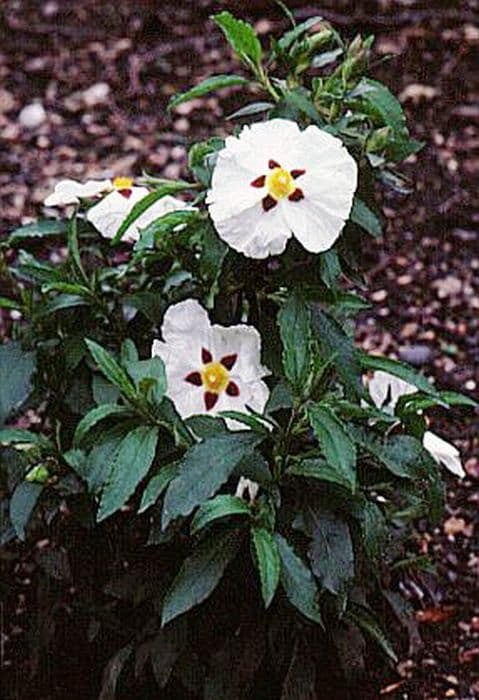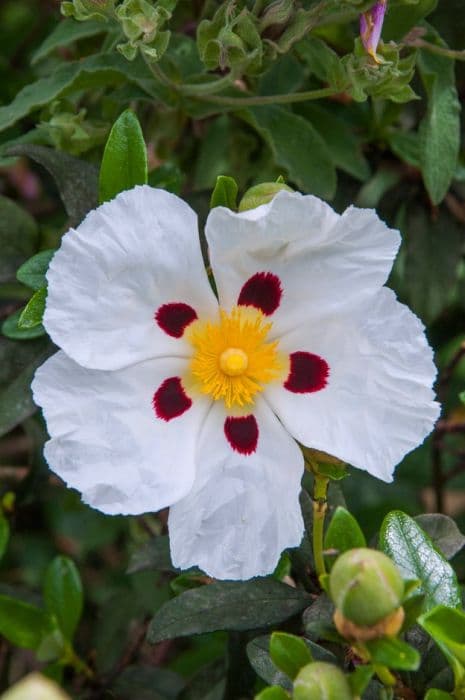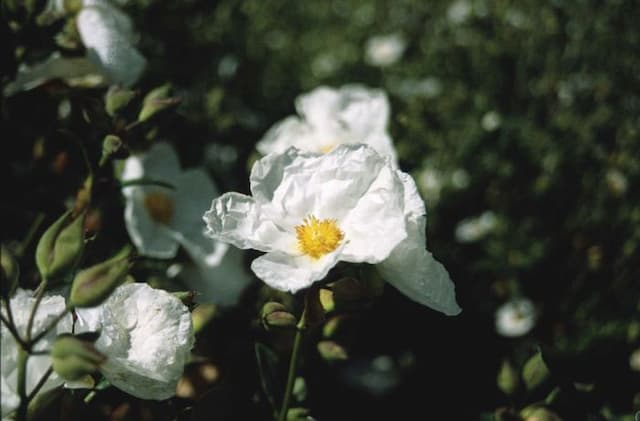Rockrose Cistus × pulverulentus 'Sunset'

ABOUT
'Sunset' rockrose is a flowering shrub known for its decorative and vivid appearance. It bears a profusion of vibrant pink flowers with a yellow center that resemble crumpled tissue paper. Each blossom typically only lasts for a single day before it sheds its petals, but the plant continuously produces new flowers over a long blooming period, which gives it a consistently colorful display throughout its flowering season. The foliage of the 'Sunset' rockrose is also noteworthy, consisting of small, ovate leaves that have a soft, wrinkled or puckered texture. These leaves are often a dusty green to gray-green color and can have a slightly sticky feel due to the presence of resins that help the plant conserve moisture. When the leaves are crushed, they give off a pleasant, resinous scent, which can be quite aromatic, especially on warm days. Overall, its blossoming habit and attractive foliage make the 'Sunset' rockrose a popular choice for gardens, where it is often admired for its bright flowers and aromatic leaves that contribute to a Mediterranean aesthetic. Its ability to produce a profusion of flowers over an extended period makes it a valuable plant for providing long-lasting visual interest in a landscape setting.
About this plant
 Names
NamesFamily
Cistaceae
Synonyms
Sunset Rockrose, Wrinkled Rock Rose
Common names
Cistus × pulverulentus 'Sunset'.
 Toxicity
ToxicityTo humans
The common name of Cistus × pulverulentus 'Sunset' is Rockrose. Rockrose is not known to be toxic to humans. There are typically no symptoms associated with poisoning because it is not considered a poisonous plant. Therefore, ingestion of any part of the Rockrose plant is unlikely to lead to toxic consequences for humans.
To pets
The common name of Cistus × pulverulentus 'Sunset' is Rockrose. Rockrose is not known to be toxic to pets. Pets that ingest parts of the Rockrose plant typically do not exhibit symptoms of poisoning, as it is not considered to be a poisonous plant. Consequently, ingestion of any part of the Rockrose plant is unlikely to lead to toxic consequences for pets.
 Characteristics
CharacteristicsLife cycle
Perennials
Foliage type
Evergreen
Color of leaves
Green
Flower color
Pink
Height
3 feet (0.91 meters)
Spread
5 feet (1.52 meters)
Plant type
Shrub
Hardiness zones
8
Native area
Mediterranean
Benefits
 General Benefits
General Benefits- Drought Tolerance: Cistus × pulverulentus 'Sunset', commonly known as the Sunset rockrose, is highly drought-tolerant once established, making it suitable for water-wise gardens.
- Low Maintenance: The Sunset rockrose requires minimal care, with no need for regular watering or fertilizing once it has settled in its location.
- Attracts Pollinators: The plant's flowers are attractive to bees and other pollinators, which can help support local ecosystems.
- Fast Growth: This plant grows relatively quickly, allowing it to quickly fill in garden spaces and provide a lush appearance.
- Deer Resistance: The Sunset rockrose is generally resistant to deer, which is beneficial in areas where deer browse is a problem.
- Erosion Control: Its dense growth habit and hardy nature make it useful for controlling erosion on slopes and banks.
- Year-Round Interest: With its evergreen foliage and flowers that bloom in late spring and early summer, it provides visual interest throughout the year.
- Landscape Versatility: This plant is versatile and can be used in a variety of landscape settings, including rock gardens, borders, and coastal areas.
- Colorful Display: The plant produces bright pink flowers that add a pop of color to garden landscapes.
- Ground Cover: Due to its low and spreading growth habit, Cistus × pulverulentus 'Sunset' serves as an effective ground cover, suppressing weeds and covering bare spots.
 Medical Properties
Medical Properties- Antimicrobial: Cistus × pulverulentus 'Sunset' has been found to have antimicrobial properties, which could help in fighting against certain bacteria and fungi.
- Antioxidant: The plant may contain compounds with antioxidant effects, which can help protect cells from damage by free radicals.
 Air-purifying Qualities
Air-purifying QualitiesThis plant is not specifically known for air purifying qualities.
 Other Uses
Other Uses- Insect repellents: The sticky resin of Sunset rockrose can be used as a natural insect repellent. This is because some insects avoid the tacky resins produced by the plant.
- Traditional crafts: The plant's resin, known as labdanum, is used in traditional Mediterranean crafts for its strong adhesive properties.
- Aromatherapy: Sunset rockrose's aromatic leaves and flowers can be used in potpourri or dried flower arrangements to provide a pleasant fragrance to a room.
- Natural dye: The flowers and leaves may be used to produce a natural dye for fabrics or crafting materials.
- Photography: Due to its attractive blooms, Sunset rockrose is often used as a subject in botanical and garden photography.
- Garden design: Its low-growing, spreading habit makes it an excellent ground cover for garden design, providing erosion control on slopes and banks.
- Edging plants: Sunset rockrose can be planted as edging along garden paths or flower beds to define spaces elegantly.
- Fire-resistant landscaping: The plant is valued in fire-prone regions as a fire-resistant element within landscapes or firebreaks.
- Wildlife gardens: Sunset rockrose can provide food and habitat for various insects, which in turn can attract birds and other wildlife to a garden.
- Culinary decoration: Although not commonly used for eating, the attractive flowers can be used as an ornamental garnish for culinary dishes.
Interesting Facts
 Feng Shui
Feng ShuiThe Sunset Rockrose is not used in Feng Shui practice.
 Zodiac Sign Compitability
Zodiac Sign CompitabilityThe Sunset Rockrose is not used in astrology practice.
 Plant Symbolism
Plant Symbolism- Resilience - Cistus x pulverulentus 'Sunset', commonly known as Rockrose, is a symbol of resilience due to its ability to thrive in poor soil conditions and recover from wildfires.
- Healing - Rockrose is also associated with healing because it has been used in herbal medicine to treat various ailments.
- Beauty and simplicity - The simple yet beautiful flowers of the Rockrose can represent appreciation for the uncomplicated beauties of life.
- Survival and adaptation - This plant adapts well to drought conditions, making it a symbol of surviving and adapting to difficult environments.
 Water
WaterThe rockrose (Cistus × pulverulentus 'Sunset') prefers moderate watering, which means that it should be watered thoroughly when the top inch of the soil feels dry to the touch. In general, this might translate to watering approximately once a week, but this frequency can vary depending on climate, season, and soil conditions. Ensure that the plant receives a deep watering, which may be around 1-2 gallons depending on the size of the plant and the environmental conditions. It is important not to overwater, as the rockrose can be prone to root rot if left in soggy soil. During the winter months, reduce the frequency of watering as the plant enters a dormant phase and requires less moisture.
 Light
LightThe rockrose (Cistus × pulverulentus 'Sunset') thrives in full sun conditions. It is best placed in a spot where it can receive at least six hours of direct sunlight each day. A south-facing garden position is ideal for this plant to grow vigorously and produce its characteristic bright flowers. Avoid shaded areas, as inadequate light can lead to fewer blooms and a leggy growth habit.
 Temperature
TemperatureThe rockrose (Cistus × pulverulentus 'Sunset') performs best in warm climates and is hardy between 20°F to 100°F. It is tolerant of heat and can handle high temperatures well during the summer months. The ideal temperature range for this plant is between 60°F and 80°F for optimal growth. Rockrose plants can sustain light frost, but prolonged exposure to temperatures below 20°F may damage the plant.
 Pruning
PruningPrune the rockrose (Cistus × pulverulentus 'Sunset') to maintain its shape and to remove any dead or damaged wood. Pruning is best done in late winter or early spring before the onset of new growth. Pruning can also stimulate the plant to produce more flowers. It's not necessary to prune the rockrose annually; however, a light pruning every couple of years can help to rejuvenate the plant and keep it looking its best.
 Cleaning
CleaningAs needed
 Soil
SoilThe ideal soil mix for the Cistus 'Sunset', commonly known as Rockrose, should offer good drainage and not be too fertile. A mix composed of loamy soil, sandy soil, and grit or perlite enhances drainage. Rockrose prefers a slightly acidic to neutral pH, ranging from 6.0 to 7.5.
 Repotting
RepottingRockrose plants generally do not require frequent repotting and can thrive in the same pot for several years. Repotting may be done every 3-4 years if necessary, to refresh the soil and to accommodate the growth of the plant.
 Humidity & Misting
Humidity & MistingRockrose prefers a low to average humidity level. It is well-suited to a Mediterranean climate and does not require high humidity to thrive. Average home or garden conditions usually suffice.
 Suitable locations
Suitable locationsIndoor
Place Rockrose in bright, sunny spot; minimal watering.
Outdoor
Plant in full sun, well-drained soil; low water once established.
Hardiness zone
8-11 USDA.
 Life cycle
Life cycleCistus × pulverulentus 'Sunset', commonly known as Sunset Rockrose, starts its life cycle from seed germination, which is often variable and can be low in viability. Once germinated, the plants enter a vegetative state, rapidly developing roots, stems, and green, leathery leaves. As they mature, they typically form a low, mounding shrub. The next stage is characterized by flowering, usually in late spring to early summer, displaying its showy pink blooms with yellow centers which last for a single day but are produced in succession over a period of weeks. After pollination, the flowers produce small capsules containing numerous seeds. The Sunset Rockrose typically lives for several years, but as a relatively short-lived perennial, it may need replacing after about 4-5 years, or can be propagated by cuttings to maintain its presence in the garden.
 Propogation
PropogationPropogation time
Spring-Early Summer
Cistus × pulverulentus 'Sunset', commonly known as the Sunset rockrose, is generally propagated through semi-hardwood cuttings. This method is recommended in late summer or early fall. A cutting of about 4 to 6 inches (10 to 15 centimeters) is snipped from a healthy parent plant, ideally from the current year's growth. The lower leaves are removed, and the bottom end dipped in rooting hormone to enhance root development. The treated cutting is then inserted approximately 1 to 2 inches (2.5 to 5 centimeters) deep into a pot filled with a well-draining soil mixture. It is essential to keep the soil moist but not excessively wet, providing a high humidity environment if possible. The cutting typically roots within a few weeks, after which it can be gradually acclimated to less controlled conditions and eventually planted out in the garden once established.









